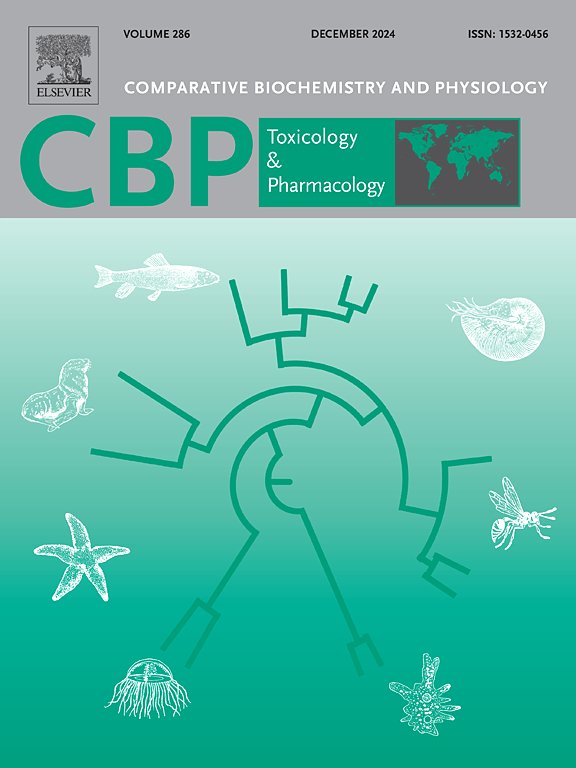中华绒螯蟹鳃组织对低氧胁迫反应的转录组比较分析
IF 3.9
3区 环境科学与生态学
Q2 BIOCHEMISTRY & MOLECULAR BIOLOGY
Comparative Biochemistry and Physiology C-toxicology & Pharmacology
Pub Date : 2024-11-19
DOI:10.1016/j.cbpc.2024.110081
引用次数: 0
摘要
甲壳类动物经常会遇到各种缺氧情况,为了应对这种情况,它们进化出了一系列抗氧化防御缺氧胁迫的能力。本研究旨在探讨中华绒螯蟹缺氧应激的生理和分子调控。我们采用降低水中溶解氧的方法对中华绒螯蟹幼体进行缺氧处理。结果表明,在缺氧条件下,中华绒螯蟹幼体鳃组织中的总抗氧化能力、超氧化物歧化酶、过氧化氢酶和丙二醛含量显著升高。此外,还利用转录组测序分析了常氧对照组(NC)、缺氧敏感组(HS)和缺氧耐受组(HT)的鳃组织。结果发现,NC 组与 HS 组、NC 组与 HT 组和 HS 组与 HT 组分别有 2124、2946 和 2309 个差异表达基因(DEGs)。KEGG通路富集分析表明,在HS与HT中,DEGs主要富集在氧化磷酸化、脂肪细胞因子信号通路和内质网蛋白加工中。在 NC vs. HS 和 NC vs. HT 的比较中,还发现了 MAPK 信号通路、细胞凋亡、胰高血糖素信号通路和花生四烯酸代谢的富集。这些通路中的 DEGs 可能在鳃耐缺氧过程中发挥了关键作用。这些结果为中华绒螯鱼幼体组织应对缺氧胁迫的氧化防御和适应性调控机制提供了新的认识和参考。本文章由计算机程序翻译,如有差异,请以英文原文为准。

Comparative transcriptome analysis of gill tissue response to hypoxia stress in the Chinese mitten crab (Eriocheir sinensis)
Crustaceans often encounter the occurrence of various hypoxic situations, and in order to cope with this situation, they have evolved a series of antioxidant defenses against hypoxic stress. The present study was conducted to investigate the physiological and molecular regulation of hypoxic stress in the Chinese mitten crab (Eriocheir sinensis). We used the method of reducing dissolved oxygen in water to treat the juvenile E. sinensis with hypoxia. The results showed that total antioxidant capacity, superoxide dismutase, catalase and malondialdehyde contents in the gills of juvenile crabs were significantly elevated under hypoxia. In addition, gill tissues from normoxic control (NC), hypoxia-sensitive (HS) and hypoxia-tolerant (HT) groups were analysed using transcriptomic sequencing. The results revealed that 2124, 2946 and 2309 differentially expressed genes (DEGs) were found in NC vs. HS, NC vs. HT and HS vs. HT, respectively. The analysis of KEGG pathway enrichment indicated DEGs were predominantly enriched in oxidative phosphorylation, adipocytokine signaling pathway, and protein processing in endoplasmic reticulum in HS vs. HT. Enrichment of the MAPK signaling pathway, apoptosis, glucagon signaling pathway, and arachidonic acid metabolism was also found in the comparisons of NC vs. HS and NC vs. HT. The DEGs in these pathways may play a key role in gill tolerance to hypoxia. These results provide new insights and references for the oxidative defense and adaptive regulatory mechanisms of gill tissues of juvenile E. sinensis in response to hypoxic stress.
求助全文
通过发布文献求助,成功后即可免费获取论文全文。
去求助
来源期刊
CiteScore
7.50
自引率
5.10%
发文量
206
审稿时长
30 days
期刊介绍:
Part C: Toxicology and Pharmacology. This journal is concerned with chemical and drug action at different levels of organization, biotransformation of xenobiotics, mechanisms of toxicity, including reactive oxygen species and carcinogenesis, endocrine disruptors, natural products chemistry, and signal transduction with a molecular approach to these fields.

 求助内容:
求助内容: 应助结果提醒方式:
应助结果提醒方式:


